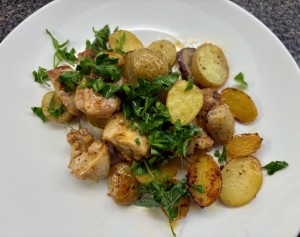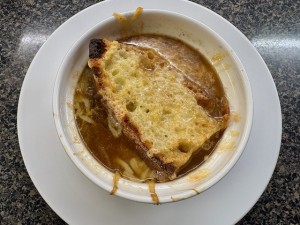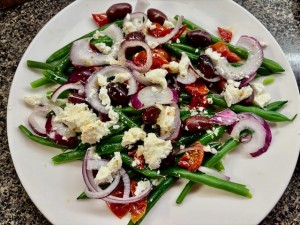This recipe from NYT Cooking yields tasty and juicy chicken thighs. At least two hours before cooking (but preferably the day before) combine lemon peel, thyme or oregano, parsley, garlic, red pepper flakes and olive oil in a large bowl. Pat the chicken thighs dry and place sage leaves and sliced garlic under the skin. Toss the chicken with the marinade and refrigerate until ready to cook. To cook the chicken, place it skin side down in a heavy pan and place another heavy pan on top (or use a lighter pan weighted down with something heavy). Cook the chicken top of the stove for about 15 minutes or until the skin lifts easily from the pan. Place lemon slices on the bottom of the pan and place the browned chicken on top. Tuck the lemon peel and garlic from the marinate between the pieces of chicken. Bake in the oven until the chicken is cooked through. Cook’s note: I used six pieces of chicken instead of nine.
Avoiding Additives and Preservatives
Use fresh lemons and herbs. Check the red pepper flakes to make sure they don’t contain colour or anti-caking agents.
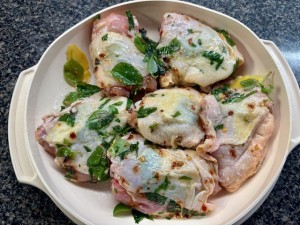
Marinate the chicken at least 2 hours or overnight
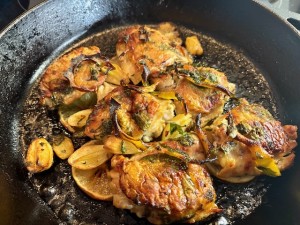
Flattened chicken thighs with roasted lemon slices
Ingredients:
2 lemons, rinsed
¼ cup (60 ml) fresh thyme or oregano leaves
1 ½ tablespoons (22.5 ml) chopped fresh sage leaves
1 ½ tablespoons (22.5 ml) chopped fresh Italian parsley
10 to 12 medium or large garlic cloves, peeled and smashed
1 teaspoon (5 ml) red chile flakes
3 tablespoons (45 ml) extra-virgin olive oil
9 bone-in, skin-on chicken thighs
18 fresh sage leaves
3 to 4 large garlic cloves, peeled and thinly sliced (to yield 18 slices)
1 tablespoon plus 1 teaspoon kosher salt
2 lemons, rinsed
Fresh thyme or oregano sprigs, for garnish
Preparation:
Make the marinade: Use a vegetable peeler to shave 9 large strips of peel from the lemons, taking care to cut into only the brightest yellow outer layer. Put strips in a large bowl or container and add thyme or oregano, sage, parsley, garlic, red chile flakes and olive oil.
Prepare the chicken: Pat each piece dry with paper towels. Using your fingers, gently separate the skin of each piece from the flesh, taking care to leave the skin attached at one end, to create a deep pocket between the skin and the flesh. Tuck 2 sage leaves and 2 garlic slices under the skin. Put the thigh in the bowl with the marinade and repeat with remaining thighs, sage and garlic. Turn the thighs gently to coat with the marinade. Cover bowl and refrigerate at least 2 hours or overnight.
When ready to cook, remove thighs from marinade and place them skin side up on a baking sheet. Reserve garlic cloves and lemon peel from the marinade; discard the liquid. Sprinkle 2 teaspoons (10 ml) salt over the chicken, then turn over and sprinkle with remaining 2 teaspoons (10 ml) salt.
Transfer 5 chicken thighs, skin side down, to a 10- or 12-inch (25- or 30-cm) cast-iron skillet. Put it over high heat and weigh down the chicken with the bottom of another cast-iron skillet. Or use a lighter skillet weighed down with a large full can, a brick or another heavy object. Make sure the bottom of the skillet is clean or place a sheet of parchment paper between the chicken and the top skillet.
Once chicken is sizzling loudly, reduce heat to medium and cook without moving for 10 to 15 minutes, until skin is brown and crisp. To check for doneness, gently lift the corner of a chicken thigh with a metal spatula. The skin will come away cleanly from the bottom of the pan when it is done. If it is still stuck, do not pull but let it cook a little longer.
When thighs are done, remove the weight and lift the chicken out of the pan, taking care to keep the skin attached to the thighs as you lift them. Transfer the thighs, skin side up, to a clean baking sheet or plate. Cook the remaining 4 chicken thighs in the same way. Pour off most of the fat from the skillet.
Meanwhile, heat oven to 450 degrees F (232 C). Cut lemons in half and squeeze gently to remove some of the juice. Cut crosswise into 1/8-inch (0.3-cm) slices and lay on paper towels to absorb more juice.
Place a layer of lemon slices in the skillet. Return all the browned chicken to the skillet on top of the lemons, skin side up. Tuck reserved lemon peel and garlic cloves down between the pieces.
Transfer skillet to oven for 20 to 30 minutes. To test, remove a thigh, pierce it on the flesh side with a knife, and check that the juices are clear and there is no redness near the bone. Remove pan from oven and let thighs rest in the pan 5 to 10 minutes. Tuck thyme or oregano sprigs around the thighs and serve from the pan at the table, with roasted lemon slices and garlic cloves. Serves 6.
From NYT Cooking
